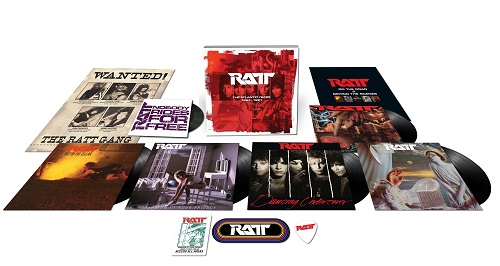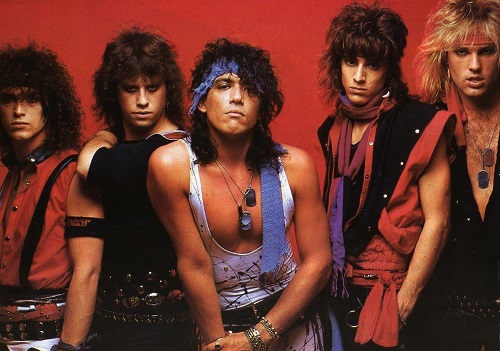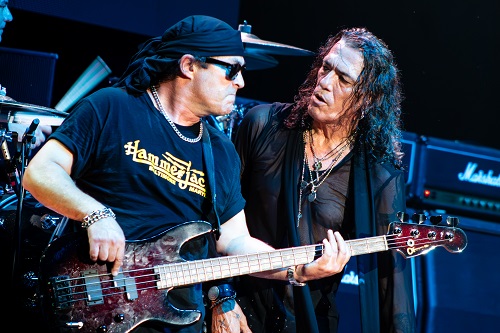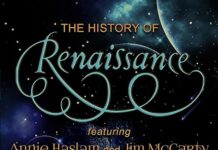By Greg Prato
In the mid-to-late 80s, glam metal was one of the most popular subgenres of heavy metal — as evidenced by the amount of bands that scored high on the charts, headlined arenas, and whose videos were heavily aired on MTV. And judging by those aforementioned categories, one of the top bands of the era was undoubtedly Ratt. Comprised of singer Stephen Pearcy, guitarists Warren DeMartini and Robbin Crosby, bassist Juan Croucier, and drummer Bobby Blotzer, Ratt’s most successful period spanned 1984-1991, when the quintet issued such Top 10 albums as Out of the Cellar and Invasion of Your Privacy, and the hit singles/videos “Round and Round” and “Lay It Down.”
In 2023, it was this specific Ratt era that received the box set treatment, with the release of The Atlantic Years: 1984-1991 (available as both vinyl and CD configurations, which collects five full-lengths, a single, plus other assorted goodies). Croucier spoke with VintageRock.com shortly after the set’s release — discussing each LP (be sure to keep an eye out for a second part of the interview, in which the bassist dives deep into the band’s history).
~
Let’s discuss the new The Atlantic Years: 1984-1991 box set. How did it come together and how was it revisiting the albums?
We’d been working on it for a year and a half, roughly two years – off and on. And it involved everybody submitting pictures from their personal archives and making different suggestions. And then we had Andy Pierce remaster the records and he did a terrific job – it sounded really, really good. I’m going to be listening to the vinyl, but what he did – the digital samples – were absolutely excellent. He brought out some of the upper mids – and that involves the guitars. So, you couple that with the analog low end from basic vinyl records, and it should made for a very interesting sound. It’s been a labor of love over a period of time – and I’m glad it’s finally out.
Beau Hill produced the majority of the albums in the set. What did he bring to the band?
Beau brought his organizational skills and his sense of arrangements, and attention to detail. He’s a very good engineer and really got a lot accomplished under the limitations that we had. Especially from the first record, Out of the Cellar — we didn’t have a lot of time to do it. He definitely “lit the fuse,” if you will — and got things done.
Let’s discuss each album in the box set, starting with 1984’s Out of the Cellar.
That album, we had had many of those songs. And at that point in time, when we did the EP — going back one record before — those were songs that we were playing in the Hollywood clubs every weekend, just about. Then came Out of the Cellar, and we had eight songs that we pretty much had ready, but we needed two more. So, I brought in a couple of songs that I had written and recorded — one called “Lack of Communication” and another one called “She Wants Money.” I played them for Beau and he really liked them and wanted to include them on the record. So, that finalized the ten songs that went on to Out of the Cellar. We also redid “Back for More” from the EP for Out of the Cellar. And again, it was a question of trying to get a lot done in a short amount of time. We did a record that should have taken three months, and we did it in…I think all in, it was maybe five or six weeks. So, it was really, really quick. We didn’t have a lot of time to second guess ourselves.
The album cover for Cellar also featured Tawny Kitaen — a few years before she appeared in the Whitesnake videos.
Tawny was Robbin Crosby’s girlfriend in high school. First, on the EP are Tawny’s legs. So naturally, the next record we were throwing around different ideas, and she was the girl for the job. Because we already knew her, she was an up-and-coming starlet, and it just all kind of made sense. We had a photographer set up the scene and get the light from the hole. There was an actual hole there — it’s not Photoshopped. (Laughs) Back in those days, you had to have some smoke coming out — it was a little bit of a production. But it came together well.
Did you realize “Round and Round” was a special song the first time you heard it?
When I came back into the group [after spending some time as the bassist for Dokken], they were working on this song — they had the parts. It was what was to become “Round and Round.” There was no recording of it, really. So, I learned what was there, and then I went home and I wanted to add something unique to it. I came up with my own bass part that in music, you call it “contrary motion” — the bass part was ascending while the guitars were descending. And it started developing. By the time Beau Hill came into the picture, we made some final changes to it — to prepare it. You never know when you’re working on songs what will translate. Sometimes, you think a really great song is going to be something, and by the time you get into the studio and record it and it’s mixed, it turns out not what you expected it to be. I don’t know that any of us thought that “Round and Round” was going to be the song that it became. It was a collaborative effort and we were all hoping that something would work, that something would stand out. And part of what helped it was that MTV was in its infancy at the time, and we made a video for it. So, that really helped catapult that — or people that had Cable TV, at least — into people’s living rooms. And that started a “familiarity” with that — via association.
What do you remember about touring in support of Out of the Cellar?
It was fantastic. After we finished Out of the Cellar, we went out with ZZ Top. And the intention was to go out for six weeks and we’d see what happened from there. We didn’t come back for 10 months. So, we went from the ZZ Top tour and jumped to a Billy Squier tour, did some club dates between on the off nights — we started headlining our own club dates – and just kept working from there. It was an opportunity to play with Mötley Crüe and Ozzy in Salt Lake City — and we took it. And then there were a handful of other opportunities to play with Mötley. The rest is history — we kept going and going.
What do you recall about 1985’s Invasion of Your Privacy?
That album was interesting in the sense that we didn’t have a lot of time to prepare for it — we’d been on tour. We buckled down and worked hard at working on new songs, and everybody was working on their own material. This time, we had a little more time and we had a little more of a budget. When we did Out of the Cellar, our equipment wasn’t the best. We only had like…one amplifier that worked really well for the guitars. So, by the time we did Invasion, we had a little bit more of a budget to deal with. And I actually walked into the studio one day, and there were approximately 20 guitar heads stacked up — and Warren and Robbin were going through the different Marshall heads, trying to find whichever one was sounding right to them at the time. It was a different approach in the sense that we knew what we wanted to improve on from Out of the Cellar, and then it was a question of crafting the songs. So, it felt like the right progression for the band to take.
I remember Ratt played some of the biggest shows of their career in support of Invasion — such as Donington and Day on the Green.
Day on the Green was absolutely incredible. Look, playing in an arena is amazing. But when you get to the point where you look around and you’re in a stadium, those kind of moments you never forget. We had worked really, really hard, and that was just a day that I’ll never forget. And then Donington was an amazing festival — it was people as far as you could see. And they had their little idiosyncrasies. At the time, they would throw things up on stage — so we’d be dodging things. They’d be throwing cups and bottles…and at one point, somebody threw a pig’s head! We were looking at it like, “Is that a mask…or the real thing?” (Laughs) It was a lot of fun — it was an adventure. You had to be on your toes. And we really wanted to make an impression — so, we were a very powerful live band. That’s what we prided ourselves on. Those were great shows. You do shows like that, and they always stand out.
During that era, it seemed like almost every month Ratt was on the cover of such magazines as Circus and Hit Parader, and was one of the biggest metal bands at that point.
We just really, really worked hard. The interesting thing about it is when you think about succeeding in music and you’re in a local band, you think of it being a certain way. We were so busy, we didn’t even have time to really take it all in. All of a sudden, we were on magazine covers and we were being interviewed for big, long articles about the history of the band and how we got to where we were. But we were so busy thinking about the next tour or next leg of the tour that was coming up…that at one point, I remember calling one of my friends here in LA, and I hadn’t spoken with him for a while, and he goes, “Hey man! You’re all over the radio here.” And I said, “Really?” Because we hadn’t been home. So, as we progressed on with Invasion and then Dancing Undercover, it was almost like keeping our focus on the goal, and not letting anything stand between us and that goal. It was a bit different than I imagined it would be before it happened.
Let’s discuss 1986’s Dancing Undercover.
That was a really interesting record, because we had been on tour and we really didn’t have as much time to prepare as we would have wanted normally. So, we sort of went into the studio unprepared. I remember I brought in a couple of songs that were finished, and we had a handful of instrumentals. We proceeded as best we could. But that point in time was an interesting time for us — because we’d been working hard and our producer, Beau Hill, had been producing a lot of bands. So, he had sort of scheduled us in for a time slot to complete the record. He really wanted to conduct the production in a way that wasn’t really working with us. We’d just gotten off the road, some of us were on our own…sort of a “night schedule.” (Laughs) And Beau was on a morning schedule. So, that started the record off on the wrong foot. But we did the best we could at the time under the circumstances. But again, it was a time where record producers were really, really important go-betweens between bands and record companies. We really wanted to cooperate as best we could, but you’re talking about five guys in a rock band…so, not everybody agreed on what the schedule should have been. But nonetheless, we got it done.

For the tour in support of that album, Ratt headlined Madison Square Garden.
I’ll tell you one memory — during “You Think You’re Tough,” I broke my low E string on a song that required the low E string almost more than any other song. Atlantic Records came to the show — Ahmet Ertegun was there, Doug Morris was there. They had sort of a banquet room in the back of the arena, and we got together there and spent some time together. The record company staff from New York finally came to see the band, and it was a really great time. That arena has a certain magic to it that’s unique. There’s a certain energy there — probably why people talk about it so often. And we could really sense it and feel it — it was a very special night. I believe we had Poison opening up for us and they did a terrific job. It was just a great night. It was really nice to finally come face to face again — because we had been working — with Ahmet and Doug, and spend a little time with them. It was a lot of fun. All in all, the whole day was just a magical day.
If I remember correctly, Ratt was so popular at the time that Cheap Trick also opened that tour.
What would happen was for example at one point, we had Queensrÿche opening up for us. And I believe it was Queensrÿche, Cheap Trick, and Ratt. And then it was decided that Poison would take Queensrÿche’s place. So, sometimes mid-tour, we would change the line-up. When Cheap Trick played with us, they were amazing. They were one of our favorite bands and to have them playing with us was like a dream come true. Just a great time.
And for 1988’s Reach for the Sky, one-time Queen producer Mike Stone produced a few tracks.
On Reach for the Sky, we wanted to take a little bit of a different course. So, we started working with Mike Stone, and Mike had been working a long time in the studio — with no breaks. He had done the Whitesnake record [1987’s self-titled release], and gone literally from record to record. We really wanted to take it up a level, and we started working with Mike quite a bit in the sense that we were trying to get tones that we hadn’t gotten before — guitar sounds, bass sounds, drum sounds. It just took us a little longer to achieve our goal. By the time that we reached a point that we should have had the record close to completion, it wasn’t really there yet. It was decided to finish the record, Beau Hill might be a better option at that point in time (to finish it). So, we got the record done and we went back out on the road and supported the album. It’s difficult when a band is making records and trying to not repeat itself and progress. You do things and there is a risk there — you’re never sure. But, on the other hand, if you don’t take chances, you’ll never know if you could have improved the outcome. So, in that sense, it’s kind of a risky business any time you change up the components that make the entity work.
What do you recall about 1990’s Detonator? Desmond Child was listed as co-producer and co-penned most of the songs.
Desmond’s a great writer — obviously, legendary. Again, we wanted to see the band evolving. We had reached sort of a point where we wanted to shake things up or change the…I wouldn’t say “the chemistry,” but change the “end product.” Anytime you have a group, it’s a compromise. So, there’s a lot of components that go into it. There’s different opinions — you have the management, a lot of record company executives. Sometimes, A&R guys get involved with bands and the repertoire of songs they prefer or not. So, we were at that point where we wanted to broaden the horizons and make a certain type of record that we thought would resonate with our fans. And it was decided to bring in Desmond — as not just a writer, but as a producer. It’s a great sounding record, there’s some really good songs on there. What ended up happening was that was when the grunge thing was sort of starting to happen — the Seattle scene was coming into view. That changed people’s tastes and what they expected — and it changed the rock scene a little bit.
And it was around that time that Michael Schenker filled in for Robbin.
At that point…when you make a record, make videos, go on the road, repeat make a record — it’s an endless cycle. It can be hard on some people. You’re traveling constantly, you play places and you forget where you played. You ask a musician, “Where were you last week?”, and they have to look at their itinerary to be able to tell you where they were last Wednesday! So, it took a toll. And it took a toll on Robbin. The collective decision was to let him have some time to address his personal issues. And at that point, we got in Michael Schenker to help us with that tour. We were trying to adapt to the situation. Michael is a terrific musician. He has extreme attention to detail. A total artist. At that time, Michael was in a really good place — musically speaking. And it was a really smooth fit. Him and Warren worked really well together. So, it made the transition a lot less stressful. By the time with the MTV Unplugged thing (that Ratt appeared on in 1991), it felt really good having Michael there. Of course, we missed our good friend and comrade Robbin — but there were certain things that were out of our control, so we made the best of the situation. MTV Unplugged was a fun time — it was a neat way to change things up.
The box set also includes the non-LP single, “Nobody Rides for Free.”
That was the last song that the classic line-up recorded — it was for the movie Point Break. It was a great recording, we had a great time doing it. The song came out really well. You always try to get the best out of each song, and we worked with an engineer/producer named Mick Guzawski — he was just absolutely terrific. It was really enjoyable, because we really got that down to the core of what made Ratt what it was. So, it was a little more stripped down in certain ways. Sort of “less produced,” if you will — because it was just one single. So, it had its own unique thing that our other songs from other albums didn’t have. I wish we could have done more at the time, but that’s the way it went.
Was there any talk of the self-titled EP from 1983 being included in the box set?
The focus for this was essentially the Atlantic years — which was preceding the EP. For a certain time period, the EP was distributed through Atlantic — but it was decided that we would focus just on the LP’s for this box set. And of course, including the “Nobody Rides for Free” single. The EP was done really quickly. We had a weekend…it was four days I think it was, to record and mix it. So, essentially four of the six songs on the EP are first takes, playing live in the studio. And the only reason why we had to re-do two other songs was because at one point, I think it was Warren that broke a string and we just wanted to get the whole thing live in one shot. And then the song “Walkin’ the Dog,” we changed the arrangement at the end — I suggested we use the intro as an outro. So, we had to incorporate how we were going to go into that — to finish the song. Other than that, everything was a first take. And we were really rehearsed — because we’d been playing these songs live. So, it was very natural to go right in the studio. And the one thing that was really unique about the EP is that we captured the band’s high energy quite well.
What do you think of the Ratt albums released after the era of this box set?
I think the main foundational period of Ratt are these records (on the box set). Beyond that, the other records are what they are. I don’t really get into saying things that maybe are not right to say. Anyone that is trying to move forward and continue on, it’s such a difficult industry. So, I really don’t have an opinion either way. I don’t want to put something out there that would be not right to say. It was what it is.
At what point was it decided that Ratt was going to split up in the early 90s?
We never “split up” — it’s just we stopped. We had been working a lot — from the EP up until Detonator. When you’re doing that, you go through a lot of changes. And one of the things we didn’t do is we didn’t take enough time off — just to digest everything. So, at that point, the grunge scene had come in full force — bands like Nirvana. We saw the scene change and we kind of sat back. And at that point, the band just didn’t continue on working. But we never really officially disbanded. It’s just we sort of stopped.
Did you keep in contact with Robbin afterwards? And did his passing in 2002 come as a surprise?
I remained very, very close to Robbin. He was one of my best friends. Back then, there were message boards — because the internet was just kind of starting up. So, I had a message board on my website, and there were a lot of Ratt fans there. So, Robbin was dealing with his health issues, and I said to him, “Hey, I’ve got a lot of fans that are asking about you.” Robbin wasn’t on the internet at that point, so I said, “I’m going to have them send me questions, I’m going to print them out, and I’m going to bring them to you.” So, I let all the guys on the message board know — I put up a thread, “ask questions.” I ended up with probably a couple inches of papers of printouts of questions from the fans. I took them over to him, and he started contacting people and calling them on the phone and answering them the best he could. It really brightened his times – he enjoyed that a lot. And towards the end, I stayed in touch with him. I spoke with him a couple of days before he passed and I knew that he was struggling. It’s very unfortunate. It’s very sad.
How would you like Robbin to be remembered?
Just as the great guitar player and person that he was. He loved Ratt. For Robbin, it was his life. It was his identity. He wasn’t just “Robbin Crosby,” he was “Robbin Crosby from Ratt.” He was a really nice human being, he had a big heart, smart, creative. I think he wants to be remembered as someone who tried to make things a little better here on this planet.
I’ve heard Ratt be called hair metal, glam metal, and straight-ahead heavy metal. Which description do you prefer?
I think there’s always categories that people try to lay on certain eras. Ratt was a hard rock band. We’ve been called a lot of things, and I don’t mind what they call us — as long as they’re still talking about us. [Laughs] But essentially, we were just an in-your-face, hard rock band. We made no apologies for what we did. We weren’t trying to reinvent the wheel — we were just trying to make it faster.
Were the 80s as wild and crazy as they say it was?
It’s one of the best times for rock music. A lot of people went to concerts, there weren’t a lot of distractions. There were a lot of groups jockeying for position, trying to out-do the next band. A lot of competition there. I just think it was a really healthy environment for music in general. There were a lot of great bands from that era — that decade.
How does Ratt’s music hold up today, and are you still in contact with the surviving members?
I think Ratt did a real good job of capturing the moment — from record to record. And a lot of factors come into it. But we paid a lot of attention to detail and really did it the best that we could with the tools that we had at the time, and the situations that we found ourselves in. I think the music stands up because we did quality work. Again, any time you’re in a group, it’s a compromise of sorts. One guy will hear it one way, another guy will hear it differently — nobody’s right or wrong, it’s just two different ways to interpret the same thing. As far as today, where Ratt is today is something that I don’t really want to address at this point, because the band’s been through a lot of changes and I think there’s a lot of information out there anyways, to deal with that.
The Juan Croucier Interview – Part 2





















